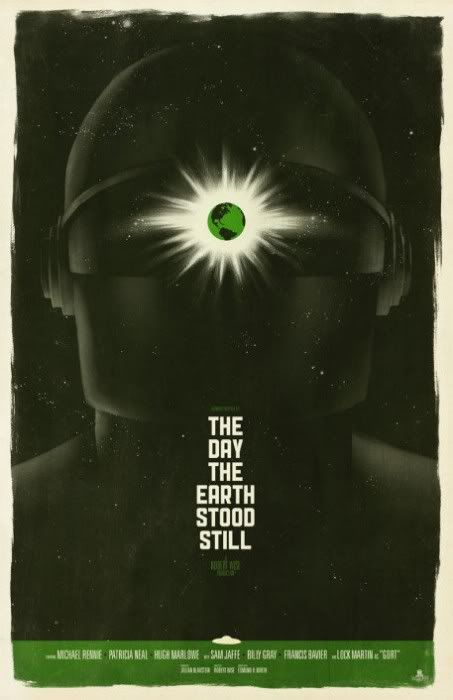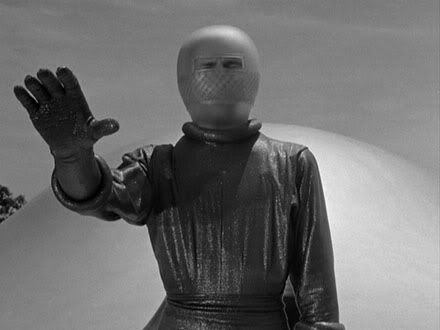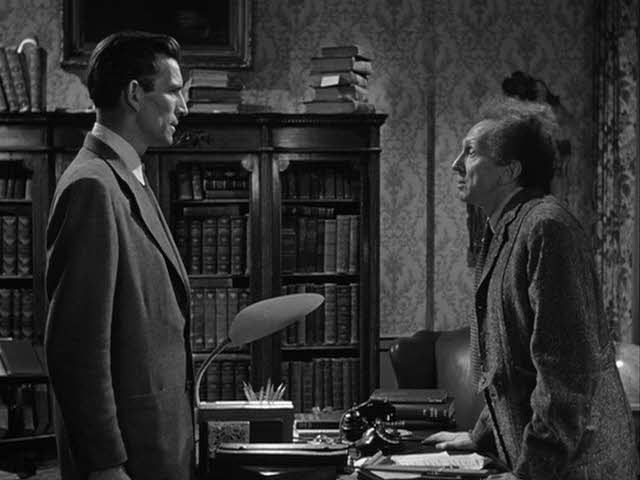 |
| Fig. 1 The Day the Earth Stood Stood Still poster. |
Robert Wise's The Day the Earth Stood Still is still a charming and very well crafted science-fiction film. Though some elements have aged poorly (such as the heroine falling randomly on to a pile of deck chairs) the general design of the space ship and the alien warmth of Klaatu are just a couple of the reasons this film is still thoroughly enjoyable now.
 |
| Fig 2. A peaceful greeting. |
 |
| Fig. 3 Klaatu and Dr Barnhardt. |
Though this interpretation is perhaps more 'pro' atomic weapons, it is still an equally valid view. These pacifist figures must do something drastic themselves to prevent the world from its own demise. However, they do use means that are entirely harmless but still very intimidating for the world's population and though the stillness created is more literal than that of the aftermath of an atomic bomb, the fear created from them is equal. This fear is used against him in the media storm surrounding his actions. Shaw explains that the film "then shows how easy it is for the media to whip up public hysteria, to the point at which Klaatu is tracked down and killed like a wild animal. A few in the audience might even have seen Klaatu as a Chist-like figure persecuted for carrying a message of peace and willing to die to save the world." (Shaw, 2007:142) Though this reference is thinly veiled, Klaatu does sacrifice himself so the world can receive his message. He is hunted down and persecuted, much like Christ was, and his resurrection at the end of the film acts a seal to provide, those aware of Christ's resurrection, certainty that he is there to protect the world and to prevent us from harming ourselves further.
The Day the Earth Stood Still had some great characters that were played so well by the actors that they have not aged at all. The ship Klaatu lands in still looks great and gorgeously sleek, where perhaps his robot, Gort does not. All things considered though this was a thoroughly enjoyable film that paved the way for a lot of science-fiction movies today.
List of Illustrations
Figure 1. The Day the Earth Stood Still (1951) The Day the Earth Stood Still Poster. At: http://www.liveforfilms.com/wp-content/uploads/2011/01/day-the-earth-stood-still-poster-453x700.jpg (Accessed on: 22/10/11)
Figure 2. The Day the Earth Stood Still (1951) A peaceful greeting. At: http://dvdmedia.ign.com/dvd/image/daytheearthstoodstill_01.jpg (Accessed on: 22/10/11)
Figure 3. The Day the Earth Stood Still (1951) Klaatu and Dr. Barnhardt. At: https://blogger.googleusercontent.com/img/b/R29vZ2xl/AVvXsEg7tP14J6w3f1vzyoTyyfYlr8uNwWT4de3-iKijXtKwia7DZ3KFZMXol_7ZHzy0Erf7iIvfMosGjBbX2TsfOl3qYRzqU9NYp6DNnKUzJR42FwmZk44Mm6b60agn_UA9Gq6uAWB-KZ_bx0ms/s1600/43_onemorethingMrKlaatu_whatisthealternative.jpg (Accessed on: 22/10/11)
Bibliography
Barsanti, Chris (2011) Filmology: A Movie-a-Day Guide to the Movies You Need to Know. USA: Adams Media
Cranny-Francis, Anne (2005) MultiMedia: texts and contexts. London: SAGE Publications Ltd.
Lusignan Schultz, Nancy (1999) Fear itself: enemies real & imagined in American culture. USA: Purdue University Press.
Shaw, Tony (2007) Hollywood's Cold War. Edinburgh: Edinburgh University Press.


No comments:
Post a Comment